Principles affected
Related pages
Material handling
Workstations
Background
Conveyors are often taken for granted and may not even be thought of as “ergonomics.” However, conveyors are certainly more efficient and create less human wear-and-tear than having to carry loads from one location to another. Thus conveyors can indeed be good ergonomics, even if they are rather traditional.
When employees use conveyors as a production line, then various workstation issues arise, such as working height, clearance, and pressure points. See conveyor as workstation.
Objectives
The goal is to eliminate the need to lift an item by providing a suitable surface to slide it on. A good rule of thumb is: “It is almost always better to slide an item than it is to pick it up and put it down.”
Ideas and Options
The world of conveyors is too large to be given anything but an overview here. An internet search for “conveyors” provides a multitude of vendor sites with a wealth of information on styles, variations, and special applications. The intent of this page is to show a number of the basic types of conveyors that have value in solving some ergonomics issues. This overview should also help the reader appreciate the diverse approaches that are available.
Basic designs
Belt and roller conveyors
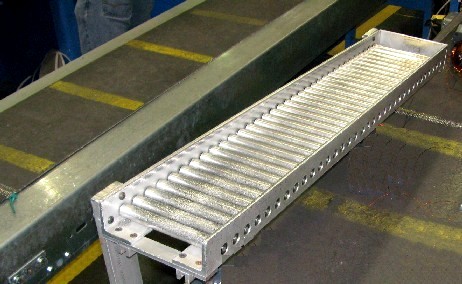 |
| Belt conveyor (left) and roller conveyor (right) |
The two most common styles of conveyors are belt and roller. Belt conveyors are usually powered. Roller conveyors can be either powered or free rolling. There are multiple variations of each.
Short lengths of conveyor
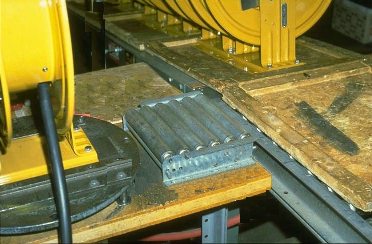 |
| Very short conveyor to slide the product (a hose reel) on the left to the takeaway conveyor at right |
Very short lengths of conveyors can provide considerable benefit at a very low cost. Usually, conveyors are thought of as running rather long distances, but short lengths can work well, especially for transfer within a workstation.
Additional comment: In the example shown in the photo above, lifting the reel is a “good” lift, in compliance with lifting guidelines — the height is at about waist level, there is no vertical distance moved, and the lateral distance is very short. Nonetheless, the short length of conveyor eliminates the need to lift altogether, making it faster and easier for the assembler, at a very low cost.
Single roller
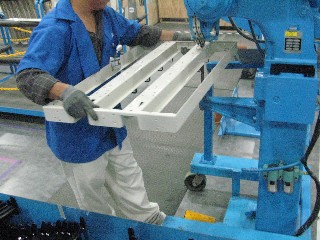 |
 |
| Strain on shoulders to hold product | Single roller stand used to support product |
Sometimes a single roller can be used, usually to support one end of a long item while the other is being worked on. Roller stands are traditional in woodworking and metal fabrication operations, but the concept has much broader application.
Gravity
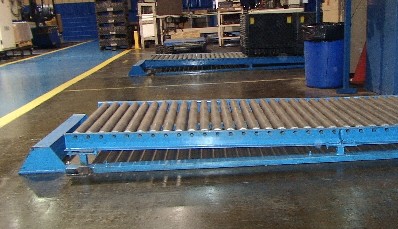 |
| Floor-level gravity conveyor |
Free rolling (unpowered) conveyors are often sloped to take advantage of gravity to move materials with minimal effort.
Flex conveyors
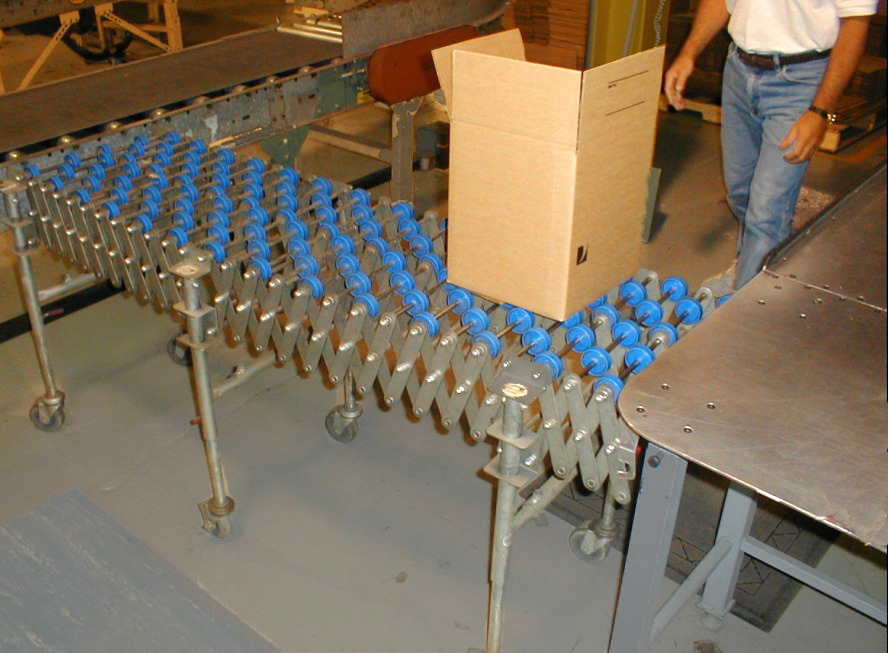 |
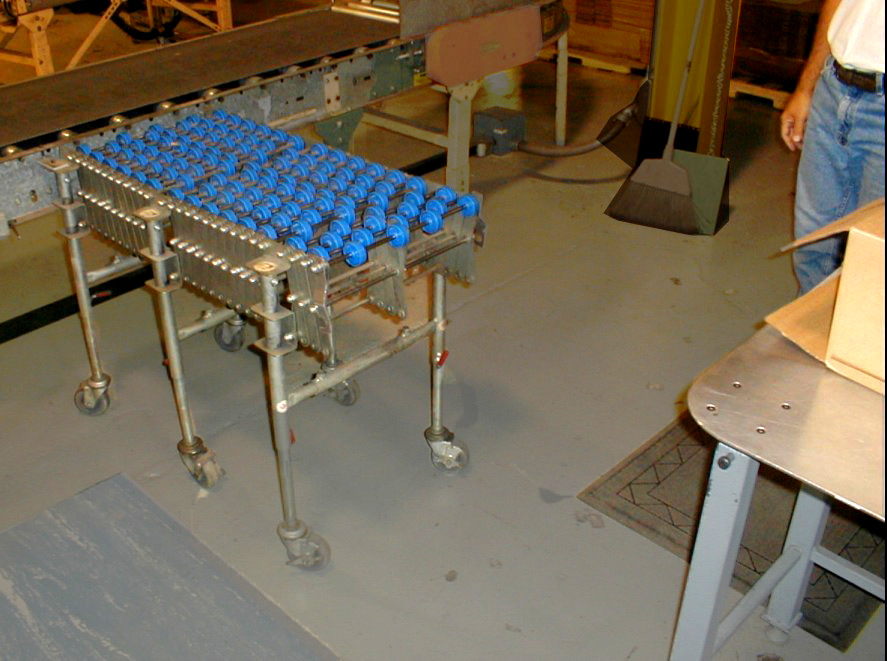 |
| Flex conveyor extended | Flex conveyor compressed |
An increasingly common type of conveyor is the flex conveyor (sometimes called “extendable” or “snake” conveyors). The particular advantages are that the conveyor can be compressed to create a passageway (see also conveyor gates) and make it easy to move to a different location. The flex conveyor can also be easily curved and oriented in different configurations.
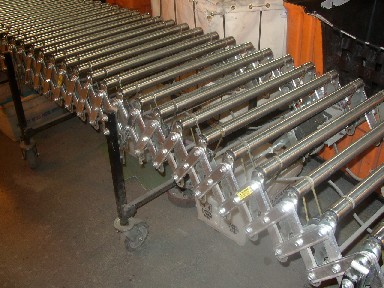 |
|
| Powered flex conveyor | Tugger to expand long length of flex conveyor |
Flex conveyors can be powered as well as designed to be mechanically extended. A common application for flex conveyors is loading and unloading trucks, since the conveyors can easily be moved in and out of the trailer bed.
Multidirectional conveyors
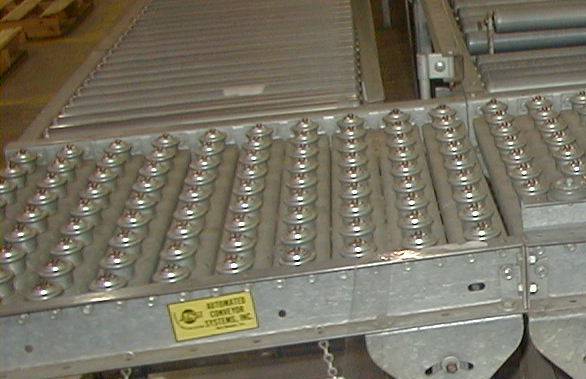 |
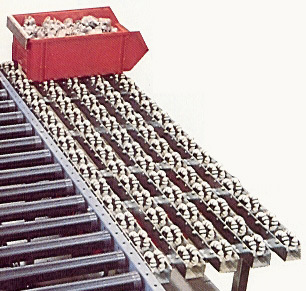 |
| Ball rollers (steel) | Plastic rollers (www.ergotechinc.com) |
Ball conveyors are often used at corners and other locations where loads need to be turned. Newer styles of plastic rollers are also available that roll more fluidly.
Inclined conveyors
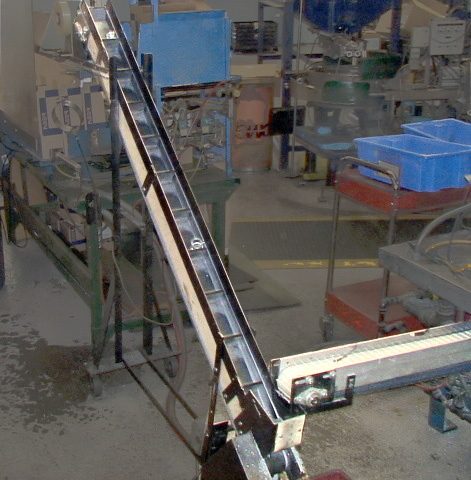 |
|
| Inclined conveyor used to transfer small parts from near floor level up to a workstation | Inclined conveyor used to lift parts up to an overhead hopper |
Inclined conveyors are often used for moving materials up to different heights. Multiple styles and configurations are available on the market. Inclined conveyors are often more efficient than manually lifting materials from one level to another, plus they reduce the risk for musculoskeletal injuries.
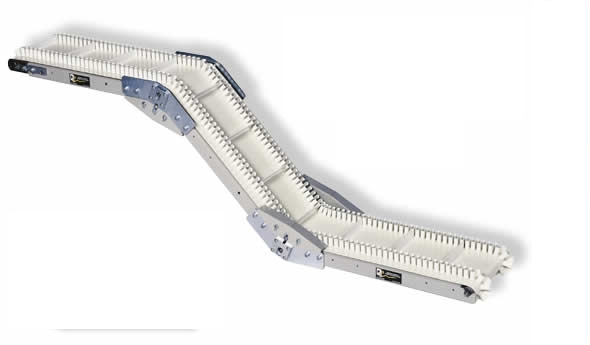 |
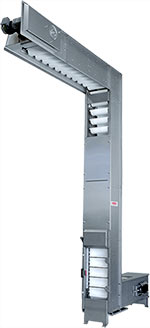 |
| Incline integrated with horizontal flow | Completely vertical rise |
Overhead conveyors
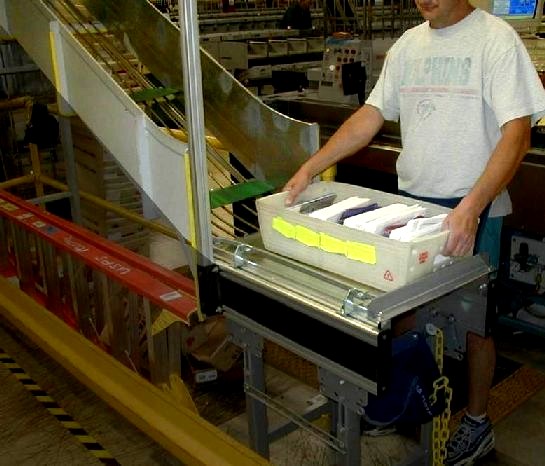 |
|
| Overhead belt conveyor system | Delivery of materials to good work height |
Belt conveyors can be installed overhead to save floor space and eliminate barriers on the main floor. Various types of inclined conveyors are used to raise materials to the overhead level. A great advantage of these systems is the ease in delivering materials to the point of use at good working height.
 |
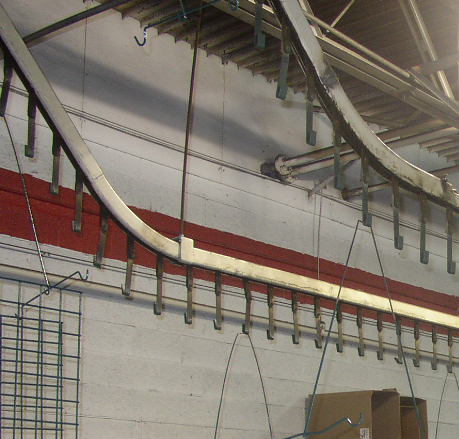 |
| Monorail junction | Monorail lowered for hanging/unhanging |
Overhead monorails are a common alternative to standard floor level conveyors. As with the overhead belt conveyor, monorails can reduce the amount of floor space needed and eliminate the barriers that floor-based conveyors create. It is common for monorail systems to hang at different heights, lower when the items being conveyed are brought down to working height, then higher to raise the items out of the way.
More variants
Adaptations
There are countless ways to adapt belt and roller conveyors to fit special circumstances and to optimize function. The following photos show several examples.
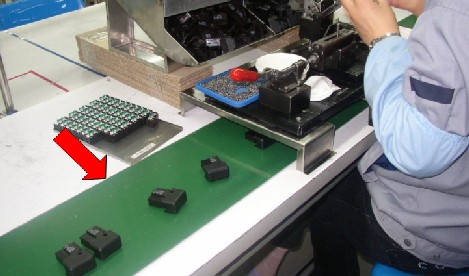 |
 |
| Integrated into workbench | Narrow |
A belt conveyor is integrated into a workbench and flush with the work surface. It is used to transfer parts to a series of assemblers
Conveyors can be very narrow, to fit small parts and bring items close to employees and thus reduce reaches.
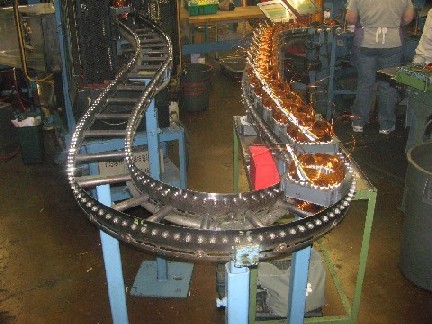 |
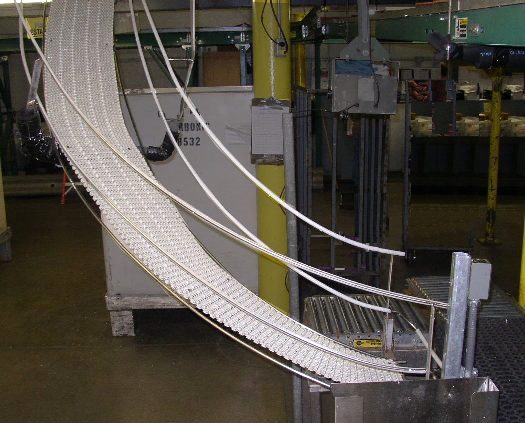 |
| Curved to fit into work area | Spiral conveyor from mezzanine to main floor |
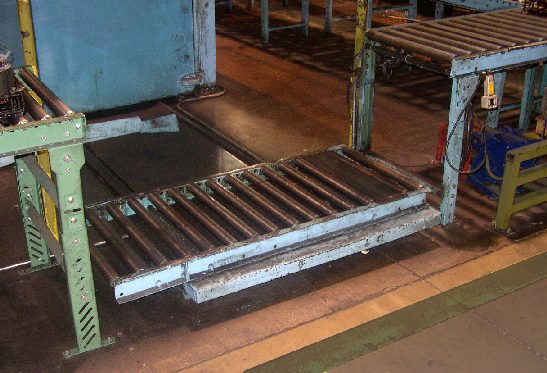 |
 |
| Integrated lift for access to a low machine | Recessed into floor |
 |
|
| Slanted |
The example above shows a slanted conveyor section used as a backstop to support items hanging from an overhead conveyor when being sanded.
Pivot and transfer conveyors
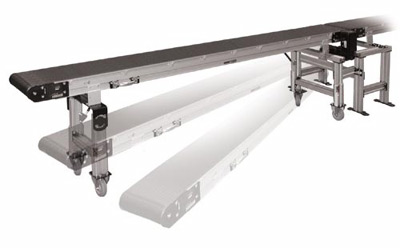 |
|
| Pivot conveyor | Conveyor transfer system |
Pivot conveyors are commercially available (left, www.dorner.com) to shift materials from one conveyor line to various delivery points. Conveyor transfer systems can be installed to shift materials from one conveyor line to another. A great deal of flexibility can be built into conveyor systems.
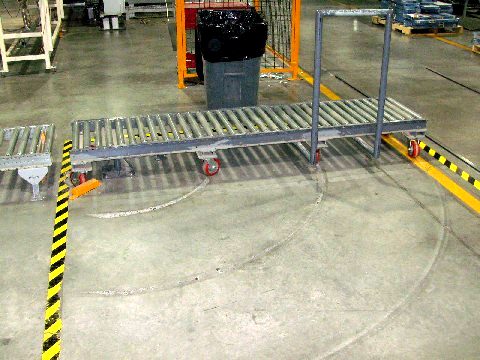 |
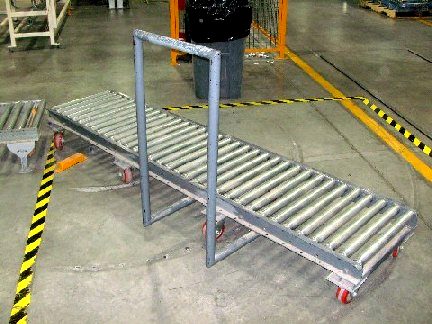 |
| Hinged section of conveyor, example 1 | |
Roller conveyors can be hinged and fitted with casters to provide access (see conveyor gates) or to move large items around corners.
 |
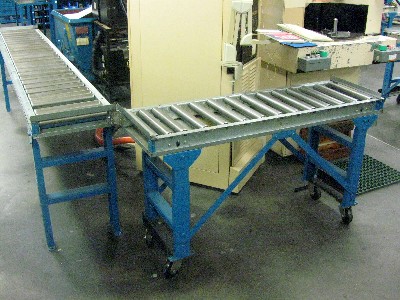 |
| Hinged section of conveyor, example 2 | |
Vacuum belt conveyors
| xx |
| Vacuum belt conveyor |
An interesting style of conveyor uses vacuum to hold items snugly onto the belt (note the holes in the belt in the photo above and the vacuum hoses attached to the side). Among other uses, these conveyors can also be placed on an incline to raise items to higher levels.
Auger (or screw) conveyors
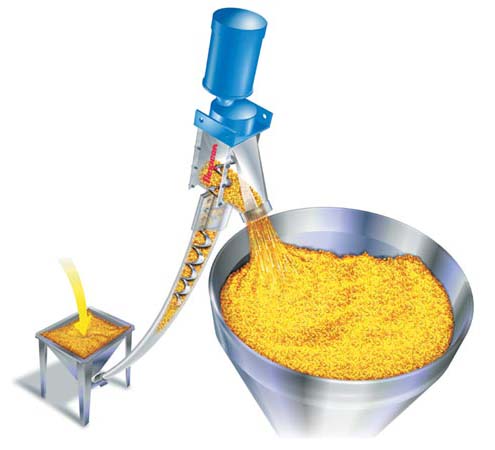 |
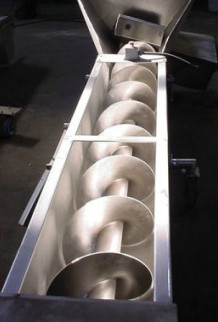 |
| Inclined auger conveyor | Horizontal auger conveyor |
Auger (or screw) conveyors are often used to handle grain or pellets, but have additional applications. The most common applications are to raise materials to a higher level, but the mechanism can be useful for horizontal transfer for appropriate materials.
Compressed air conveyors
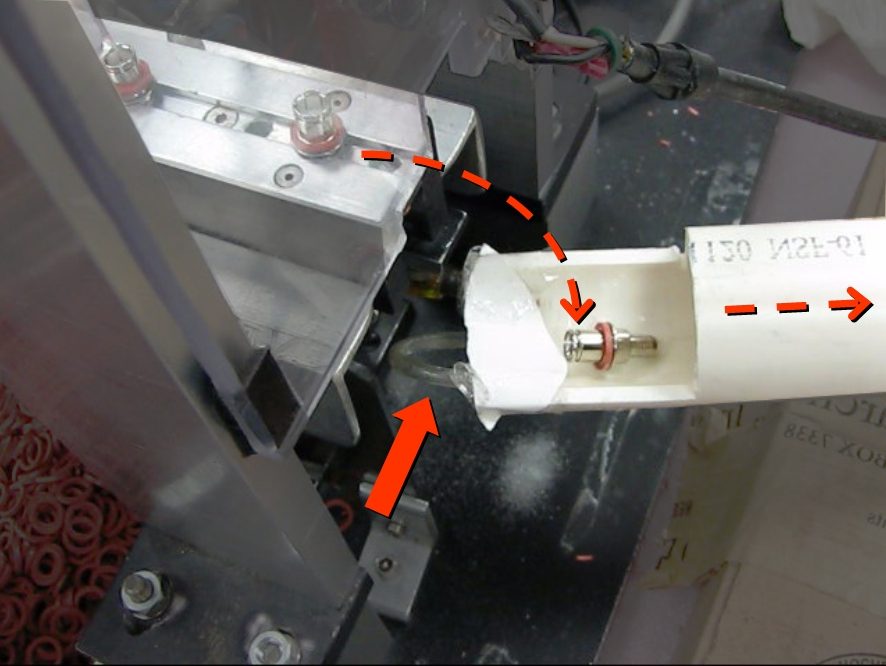 |
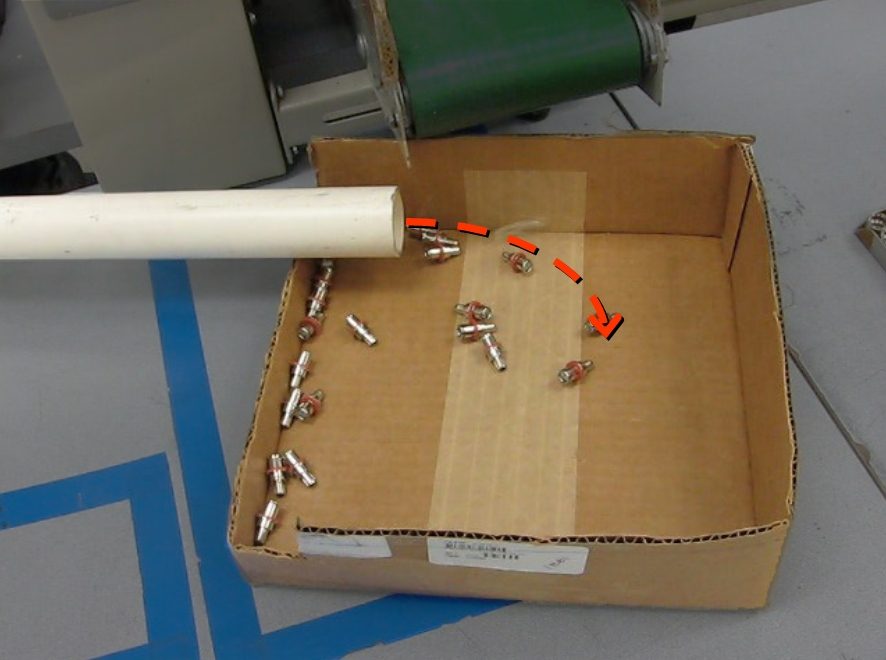 |
| Part drops into path of air jet | Part exits into box (Click for video clip) |
This examples shows a homemade air conveyor using a PVC pipe and a small tube of compressed air (solid arrow – difficult to see in photo). The part drops from the machine into the PVC pipe into the path of the air jet (dotted arrows).
The PVC pipe delivers the part to the opposite side of the assembly bench, about 10 ft. (3 m) away.
Air can be remarkably powerful when compressed and can be used to push even heavy loads for rather long distances, even straight up. Air conveyors can be easily constructed, as shown in the example in the photos above. A small plastic tube blows a stream of air into a PVC pipe. When the parts drop into the open end, they hit the blowing stream of air and are immediately shot down the pipe with surprising velocity and force.
Vacuum hose conveyors
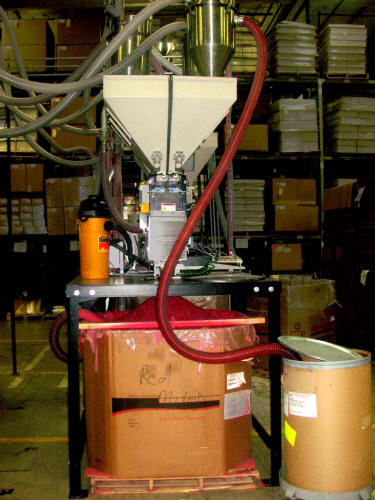 |
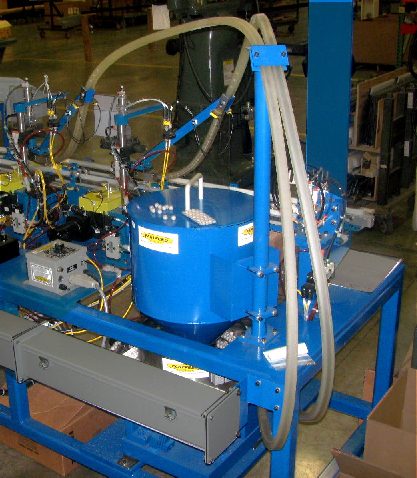 |
| Vacuum system to lift powder from barrel to overhead hopper | Vacuum hose to transfer small parts from hopper to point of assembly |
Vacuum hose systems can also be used. The most typical application is for handling powders, but the systems can also be used for small parts, usually the more spherical or cubical the better.
Common problems and solutions
Conveyor height
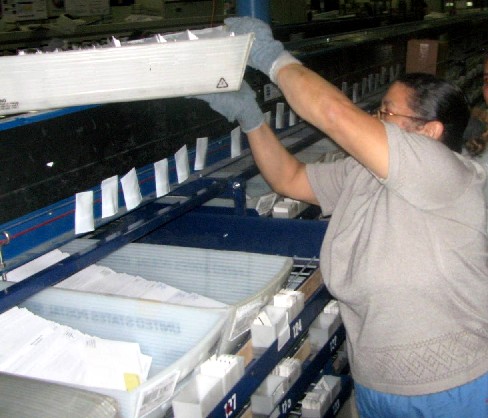 |
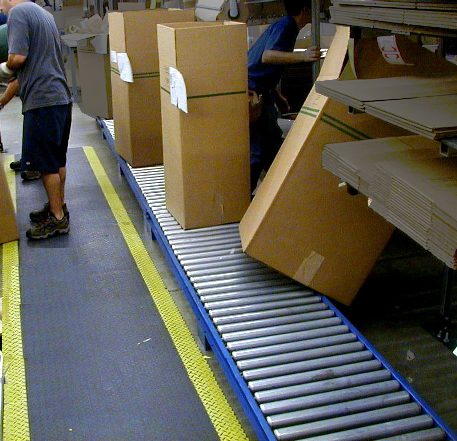 |
| Poor — very high conveyor | Good — ground level conveyor for large boxes |
Conveyors are sometimes installed at inappropriate heights, typically too high (see height). Sometimes it can be difficult to place the conveyor at a lower level because of placement of other equipment. Other times, the problem is a misunderstanding of the height objective, for example, putting the conveyor at “standard” waist height when the product being worked on is tall. When different heights of products are run down the same conveyor line, scissors lifts can be placed under the entire line to raise or lower it as needed.
Thick vs. thin conveyors
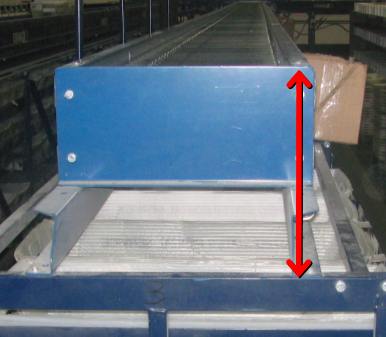 |
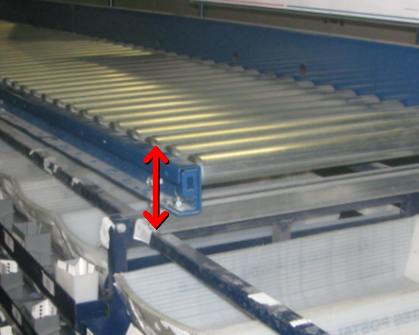 |
| Before: Thick conveyor, too high | After: thinner conveyor, lower |
In some circumstances, conveyors that are too high can be lowered by using thinner versions. In the example in the photos above, the change to a thinner conveyor made a significant improvement.
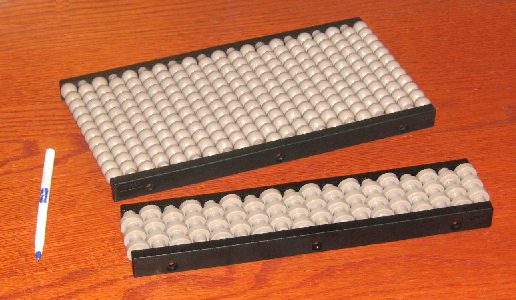 |
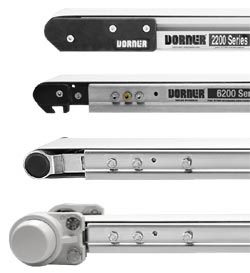 |
| Highly compact plastic conveyor (samples, www.solus.com) | Low profile conveyors (www.dorner.com) |
Thin, compact conveyors provide many advantages in workstation design, since they minimize the space needed for effective use.
Drooping belts
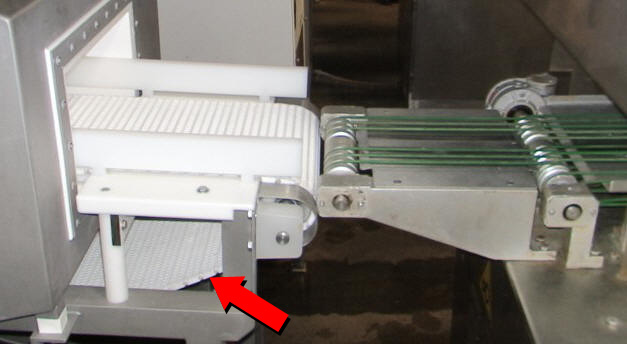 |
| Drooping belt |
A common reason why conveyors take too much vertical space is because the looped belts are allowed to droop. Tightly looped or thinner design conveyors help solve the problem. Thin conveyors can also be helpful in bringing materials closer to employees, thus reducing time and effort to reach.
Stops
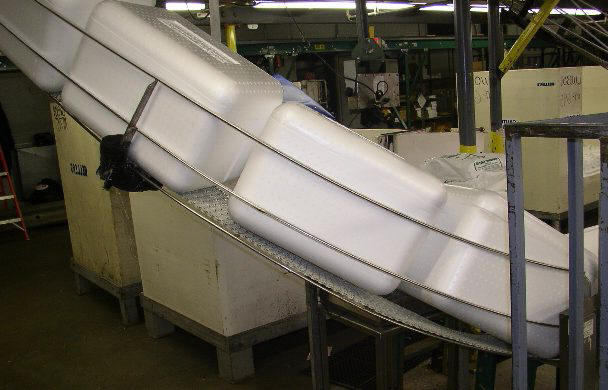 |
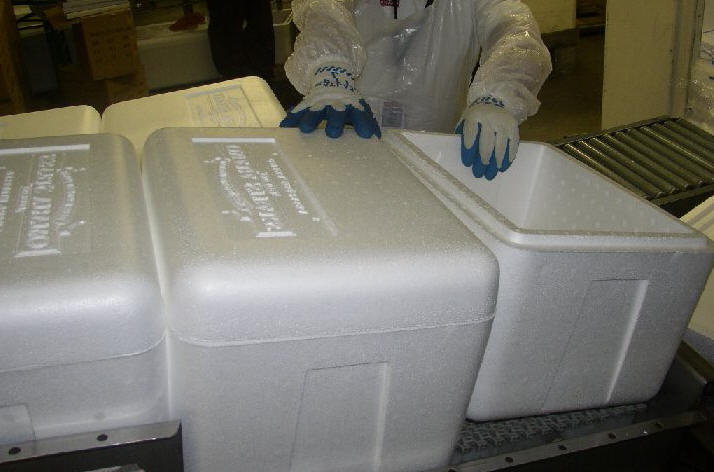 |
| Multiple containers on gravity conveyor line | Pressure of multiple containers makes removal difficult |
A problem with gravity conveyors arises when a number of boxes or containers fill the line. The combined pressure can make it difficult to remove a single unit from the conveyor. Often employees must push back the whole line of boxes or containers to create enough space to be able to remove a single one. If the loads are heavy or the stack of boxes or containers is long, it can require high force to push them back, especially when done repetitively. Usually a stop of some type is needed.
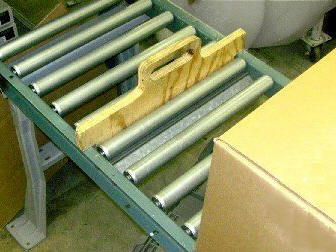 |
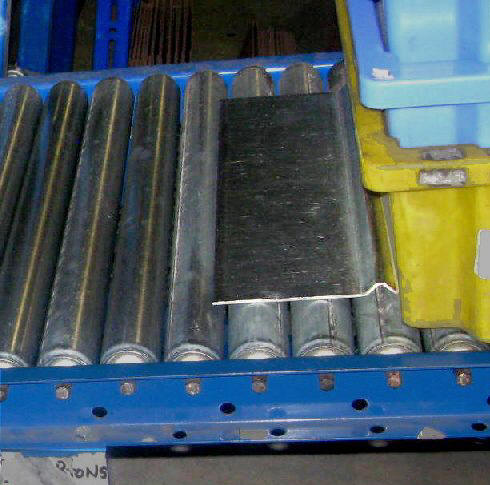 |
| Wood stop with handle | Metal stop |
The most common type of stop is just a block of wood jammed in between the rollers. Some versions, like that shown in the example above, have a handle and are configured to fit nicely. Metal stops are also available on the market or easily made.
However, occasionally, simple stops like this can create their own problems. It can take time and effort to remove the stop to allow the items to roll, and sometimes it is necessary to push the items uphill in order to be able to remove the stop. If the loads are heavy, or if there is a long line of items backed up on the conveyor, pushing uphill can be a problem.
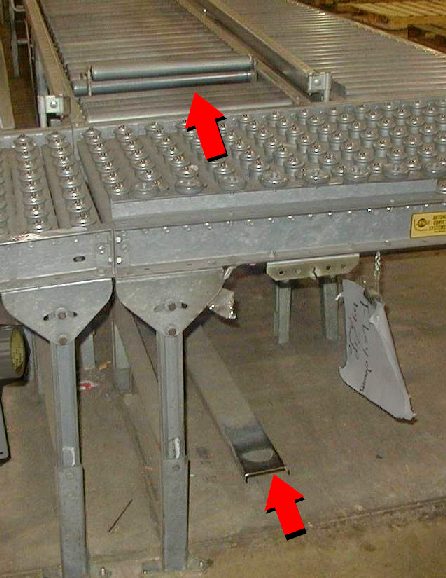 |
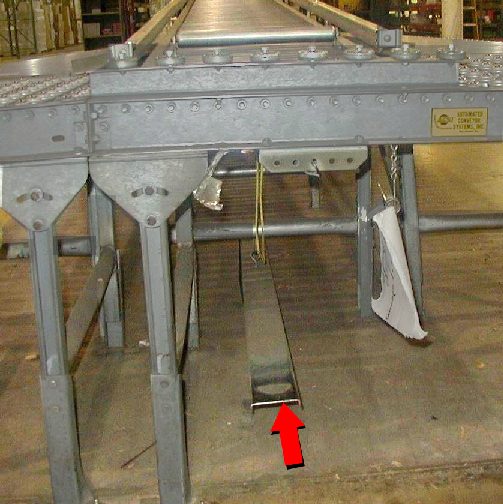 |
| Foot pedal stop: Top arrow, roller stop. Bottom arrow foot pedal control for roller stop. | Arrow: Closer view of foot pedal and cord that connects to roller stop. |
Powered stops are commercially available, but the above photos show a low-cost, homemade stop that is operated with a foot pedal. A roller is used here as the stop, connected to the foot pedal with a cord. Consequently, it is possible to remove and replace the stop very quickly, with little effort.
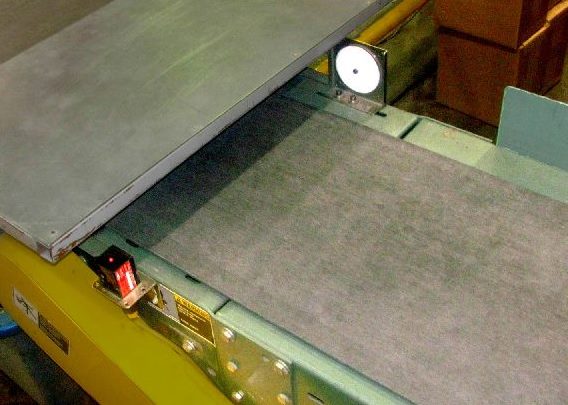 |
| Photoelectric stop (belt conveyor) |
Belt conveyors are commonly fitted with photoelectric stops. However, on occasion, additional stops can be helpful and can easily be added
Heavy pull
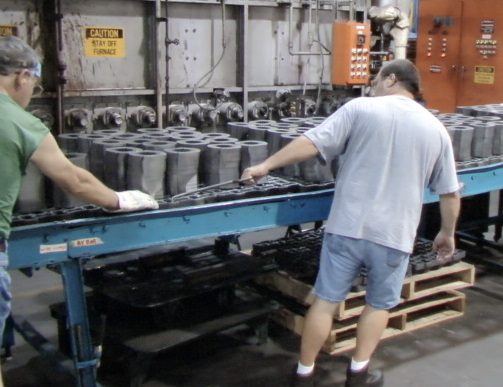 |
| Two large men to move heavy load on roller conveyor |
A rather common problem is overloading a roller conveyor, which then requires a heavy pull to move loads. In these situations, usually the best options are either to (1) add power or (2) slope the conveyor to take advantage of gravity. To use gravity, sometimes it is necessary to integrate a powered incline conveyor into the system (or a lift or some equivalent) to raise the load high enough so that gravity can be effective.
Diverters for wide conveyors
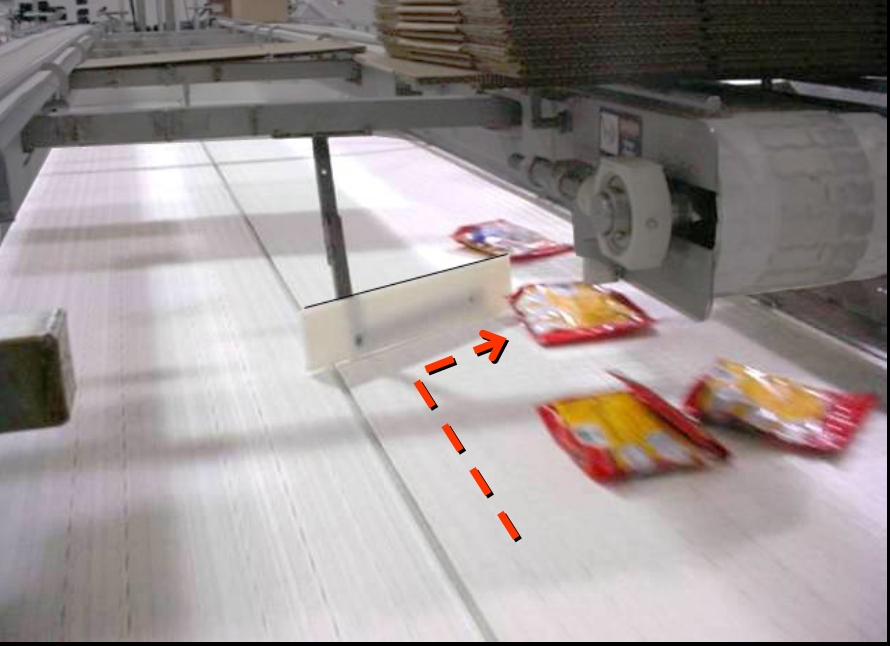 |
| Diverter |
Conveyers often need to be very wide to handle different types and quantities of products. But if the products need to be pulled from the conveyor manually, the width can create long reaches. A low-cost and effective solution is to use diverters to push the products closer to the edge of the conveyor where they can be more easily picked up. Automatic diverters are also available that can quickly switch the flow of the products down the belt to various locations.
Lateral adjustment
 |
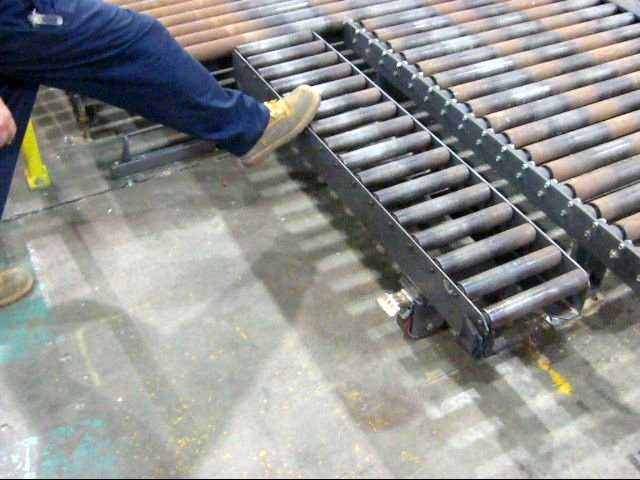 |
| Section of conveyor on casters, easily moved to adjust for width | |
It is common to use a single conveyor line to handle items of different sizes. However, sometimes this approach can create a long reach. The example above shows a portion of a conveyor on wheels (with a track for one set of wheels), thus enabling a change in the width of the full conveyor. The example below shows adjustable backstops that are used to keep narrow items close to the working side of the conveyor (similar to a diverter)
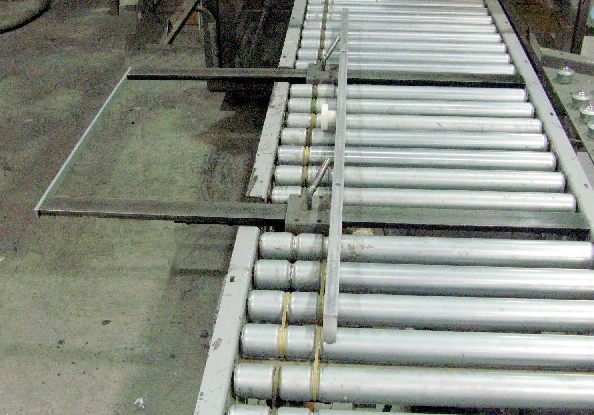 |
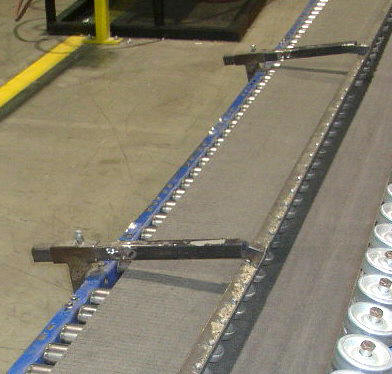 |
| Adapters on conveyor lines to allow adjustment for items of different widths | |
Special Applications
Die changeover
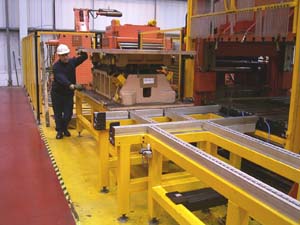 |
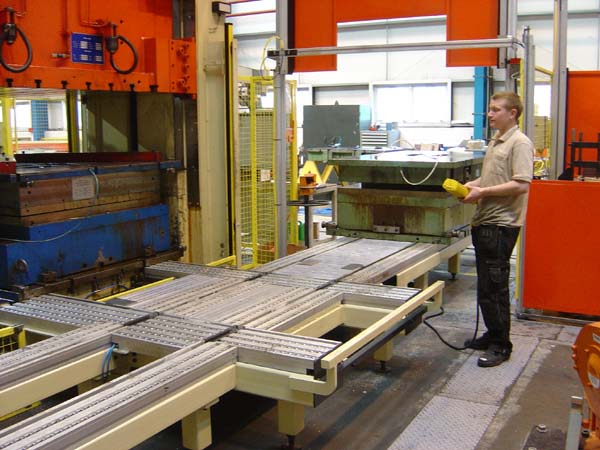 |
| Conveyor systems used to speed the exchange of dies, with much less manual effort | |
An excellent example of the use of conveyors in recent years is changing dies in stamping press operations. Changeovers that previously required hours now can be done in minutes.
The core of the improved die changeover system involves a conveyor system that allows employees to stage the incoming die on one wing of the conveyor (shown in photo above), then pull out the outgoing die from the press and roll it to the other wing, and finally roll the new die into place in the press. Previously, die changeover often involved cumbersome use of forklift trucks, hoists, come-alongs, and considerable manpower.
This concept can be applied in countless other types of operations where parts or pieces of equipment are moved in and out. Benefits typically save both time as well as wear-and-tear on people.
